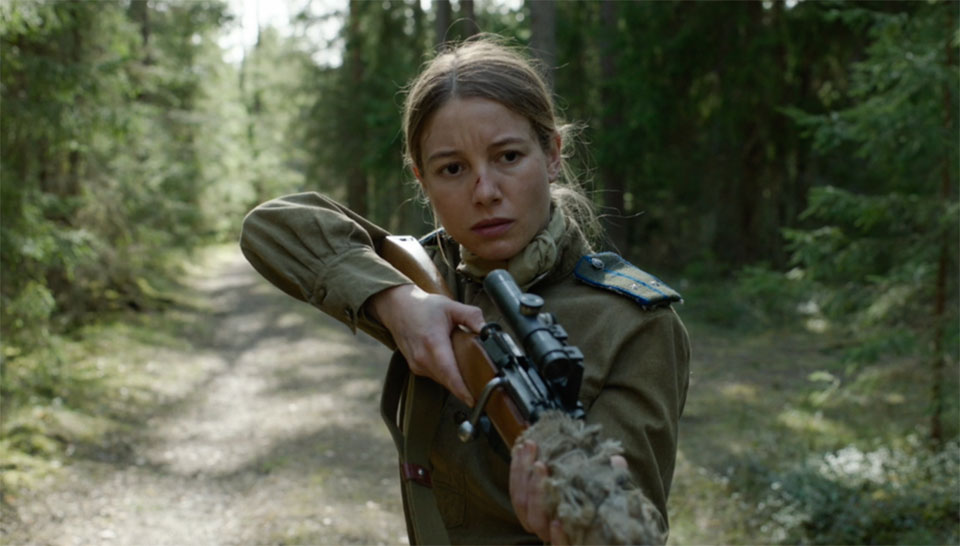
The problems of ‘fake news’ and disinformation that seem to be running rampant in today’s society didn’t just spring up in the last few years. Since history has been able to be told there have been conspiracy theories, outright lies, and coverups by various groups for various purposes. Often it has to do with power, and as the saying goes, knowledge is power. Those who control the knowledge can control the power, or at least the power over people’s minds and decisions. Perhaps one of the best examples of this is the great “mystery” around the demise of the fascist dictator Adolf Hitler. The new fictional period thriller Burial grapples with this topic in a smart and decisive way, where Hitler’s body, just like his legacy, takes on a symbolism that still haunts us today.
Written and directed by Ben Parker, Burial is set during the waning days of World War II. The film tells the fictional story of a small band of Russian soldiers tasked with delivering the dead body of Hitler back to Soviet Union leader Joseph Stalin in Russia. While carrying out this covert mission through war-torn East Germany, the unit is attacked by German “Werewolf” partisans and picked off one-by-one. Charlotte Vega stars as Brana Vasilyeva, an intrepid female intelligence officer who leads her surviving comrades in a last stand to ensure their cargo doesn’t fall into the hands of those who would hide the truth forever. What viewers are in for is a bloody action filled movie with significant bits of engrossing characters, taking on themes dealing with the brutality of war, hate, and misinformation.
Since this is a movie about war there are gunfights, blood, and violence that remind the viewers of the stakes involved. Yet, director Parker also manages to create an intimate environment that allows us to get to know a number of the characters in significant detail. This is important because this isn’t just some heist movie all about the action. It is through getting to know the various characters that we’re able to understand the figurative weight the corpse of this fascist ruler carries with it. It is in those quiet moments by the campfire, and in between bloody battles, that we get a glimpse into what that dead body means for each person involved. What comes with that knowledge is a real glimpse into the lives of those who were caught up in WWII and the trauma they endured. The violence is balanced out with quality character moments.
If you’re a history lover you will probably enjoy Burial because it not only touches on the period of WWII, but also on the 1991 fall of the Soviet Union. Both of these instances greatly impact our main character Brana in layered ways. There’s also things to learn from the film if you didn’t know about them before. Such as the existence of German soldiers, deployed behind enemy lines, who refused to surrender to the Allied Forces. These supporters of Hitler banded together into groups of guerrilla fighters that called themselves “werewolves,” and carried out their own self-styled mission to prevent the collapse of the Third Reich. These werewolves are our main antagonists in Burial.

Further, by having two timelines (of 1945 and 1991) the film showcases the fact that no moments in history exist in a vacuum, and all moments are interconnected. Such as, just as there were “werewolves” who refused to let the idea of Hitler die with his body, and aimed to cover up his death, there are those in modern times who aim to do the same in the hopes of making Hitler more than a man, but some god-like figure representing their fascist ideals.
To be clear, Hitler killed himself in his underground bunker in 1945. This has been confirmed through various testimonies and scientific evidence. Yet, there remains countless tv series, writings, and documentaries that seem obsessed with playing into conspiracy theories that the dictator somehow escaped, and continued to carry out his Nazi ideals in the shadows. The soldiers in Burial, particularly Brana, have a goal to prevent conspiracies like these from ever taking place. Brana wanted the world to know that Hitler was no genius or god. He was flesh and bone. The other side wanted to create a legend. This showcases the power of misinformation even before the age of the internet.
Another stand out of the film is the fact that a woman soldier is at the center of it all. Often, stories told in this time period focus on the men who fought in the war. It is a welcomed change to zero in on a female character instead. Especially since WWII had a significant number of women enlisted in military jobs. The Soviet Union reportedly had an estimated 80,000 women enlisted in the Red Army. These women served in a variety of roles, such as anti-aircraft gunners, tank drivers, pilots, and snipers. So no one can accuse Burial of shoehorning in a “woke agenda” that places a woman soldier in such an important position in 1945.
Vega brings a quiet strength to the role of Brana. Tom Felton, who plays a Polish-German soldier who deserted the Nazi army, gives a powerful perfomance as well. Barry Ward stands out as Tor, a Soviet soldier with deeper layers and unaddressed traumas. These performances, plus a small but strong supporting cast, help to exemplify that in war there are no real victors, and no side comes out truly unscathed. This narrative may ruffle some feathers depending on which side of the political spectrum you fall on, but it will have people talking nonetheless.
At 95 minutes Burial is an intense and interesting glimpse into an important moment in our past that greatly affects our present times. People may not agree with all of the depictions, but if nothing else it may inspire viewers to dig into history.
Burial is available in theaters and anywhere movies are rented September 2, 2022.












Comments